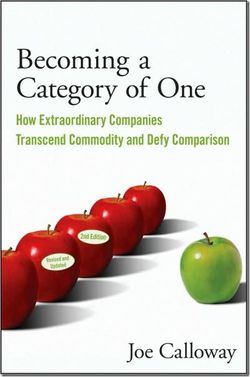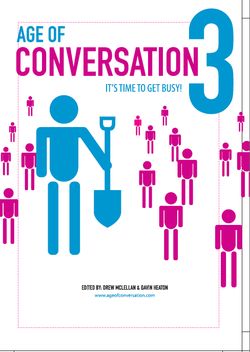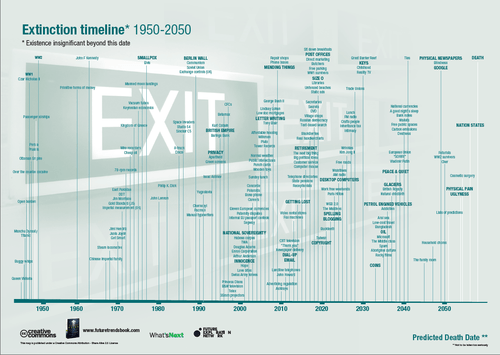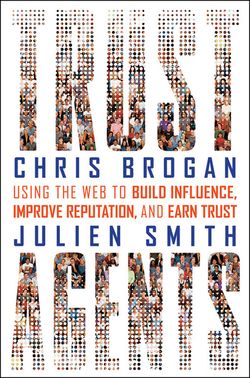January 3, 2010
 As many of you know, there are two books I wish I had written. Steve Farber's Radical Leap and Joe Calloway's Becoming a Category of One.
As many of you know, there are two books I wish I had written. Steve Farber's Radical Leap and Joe Calloway's Becoming a Category of One.
Joe's book originally came out in 2003 and when I read it…I was astonished at how brilliantly he laid out the rationale for branding. So when he put out a 2nd edition in 2009 I knew it was going to be worth the re-read. I was right. I highly recommend this book. (You can buy it by clicking here)
Recently, I had a chance to chat with Joe via e-mail and ask him a few questions about the new edition. Here's what he had to say:
What prompted the update — what of significance has changed that would require you to add to the already excellent book?
It's amazing how quickly information can become outdated. Just look at the classic by Jim Collins "Good To Great." One of the "great" companies in that book – Circuit City – went from good to broke! They're out of business.
In my book, I had referenced examples like a very successful internet campaign by BMW that, a few years later, probably no one would remember, so I took that example out. A lot of the updating was of that nature – taking out dated material and replacing it with fresh examples.
When the book originally came our, Zappos.com didn't even exist. Now they're a prime example of a Category of One company.
I also added two totally new chapters. "Tiebreakers" is an entire chapter devoted to ways great companies differentiate themselves from their competitors. "The Future Category of One" is a great new chapter that's made up of what twelve thought leaders in business think it will take to be a Category of One company in the future.
How do you think social media impacts how a company can/should become a category of one? What’s your favorite example of a company harnessing social media for this purpose?
I think that the business world is still figuring out how to harness social media. It will be interesting to see how it unfolds. To this point I think that some of the most effective social media marketing is being done by companies who have customer comment sites that let customers say what they think – uncensored and unfiltered.
To create a truly honest customer feedback site builds tremendous credibility in this marketplace. Lego is a pioneer in letting customers actually have a huge say in new products, etc. through their web site. That's not social media, per se, but it's using the idea of free communication to build customer interest and loyalty.
A micro version of tremendously successful use of social media is the mobile restaurant in Los Angeles (their names escapes me) that serves Mexican-Korean food (that's not a typo) from a truck that moves around LA. They put out their next location via social media, i.e. Twitter, and people show up in droves. Here's an important lesson, though – you have to have a great product or service to start with. All the brilliant social media marketing in the world won't make up for a second rate product.
In your opinion, why don’t more companies truly brand themselves/become a category of one?
Well, to brand yourself as a Category of One company, you have to be able to deliver on that promise. Most companies will say they're "better" than the competition – but they can't prove it. It's just lip service.
To me, the ultimate Category of One company is probably Apple. They not only invent new products – they invent new categories of products. Their Apple Stores have created a whole new way of doing business in retail.
The key question is this – what are you willing and/or able to do that your competition is not willing and/or able to do? Until you can answer that – you're no Category of One.
Most of your examples are retail in nature. How do your ideas apply to the B to B sector?
The reason I use so many retail examples is that everybody is a retail customer. Everyone can relate to retail because they experience it. What's interesting is that the exact same principles apply to B2B.
The top factors in B2B buying decisions are "be easy to do business with" "understand our needs" and "be trustworthy." NO different than retail. No matter what business you're in, if you can fulfill those three customer expectations better than your competitor – you win.
Finally — if a company leader reads your book and knows they need to do some work to become a category of one company — what advice would you give them, in terms of actually getting it done?
Don't make it complicated – it's not. Take action. Assign responsibility, accountability, put a deadline on making it happen then GO. The problem isn't not knowing what to do. Everyone knows what to do. The problem is in not DOING what we know will work. Of course there's more involved, primarily having to do with building a culture and a mindset of excellence. That takes time. But there's magic in taking action. Stop thinking about it and do it.
Oh. And feel free to bring me in to help!!
Drew's Note: The FCC would like you to know that I received Joe's new edition as a free review copy and that if you click on the links to Amazon, I'll make a few pennies as an affiliate.
More
 Gavin and I are feeling like proud parents about now….exhausted, a bit worn thin but very, very excited. We shipped the final, edited manuscript for Age of Conversation 3: It's Time to Get Busy off to the publishers (more details soon!) this week and we're almost home.
Gavin and I are feeling like proud parents about now….exhausted, a bit worn thin but very, very excited. We shipped the final, edited manuscript for Age of Conversation 3: It's Time to Get Busy off to the publishers (more details soon!) this week and we're almost home.
![Reblog this post [with Zemanta]](http://img.zemanta.com/reblog_e.png?x-id=3fb04075-da27-4b48-a1c4-399e838f5448)

![Reblog this post [with Zemanta]](http://img.zemanta.com/reblog_e.png?x-id=0f6a7258-55ab-42dd-9f7c-560723939e48)




![Reblog this post [with Zemanta]](http://img.zemanta.com/reblog_e.png?x-id=a8549f3d-7a31-4f1a-bfa5-9454c669aab5)

![Reblog this post [with Zemanta]](http://img.zemanta.com/reblog_e.png?x-id=faa714e5-0c98-40b2-9f3e-ada88507b2dd)

![Reblog this post [with Zemanta]](http://img.zemanta.com/reblog_e.png?x-id=229b6b9a-0723-4a6a-a3bf-fde610487a0c)